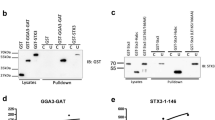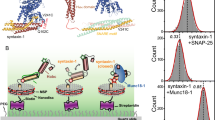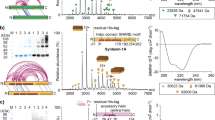Abstract
Syntaxin 1a and neuronal Sec1 (nSec1) form an evolutionarily conserved heterodimer that is essential for vesicle trafficking and membrane fusion. The crystal structure of the nSec1–syntaxin 1a complex, determined at 2.6 Å resolution, reveals that major conformational rearrangements occur in syntaxin relative to both the core SNARE complex and isolated syntaxin. We identify regions of the two proteins that seem to determine the binding specificity of particular Sec1 proteins for syntaxin isoforms, which is likely to be important for the fidelity of membrane trafficking. The structure also indicates mechanisms that might couple the action of upstream effector proteins to conformational changes in syntaxin 1a and nSec1 that lead to core complex formation and membrane fusion.
This is a preview of subscription content, access via your institution
Access options
Subscribe to this journal
Receive 51 print issues and online access
$199.00 per year
only $3.90 per issue
Buy this article
- Purchase on SpringerLink
- Instant access to full article PDF
Prices may be subject to local taxes which are calculated during checkout






Similar content being viewed by others
References
Palade, G. Intracellular aspects of the process of protein secretion. Science 189, 347–358 ( 1975).
Südhof, T. C. The synaptic vesicle cycle: a cascade of protein-protein interactions. Nature 375, 645–653 ( 1995).
Sutton, R. B. et al. Crystal structure of a SNARE complex involved in synaptic exocytosis at 2.4 Å resolution. Nature 395, 347–353 (1998).
Poirier, M. A. et al. The synaptic SNARE complex is a parallel four-stranded helical bundle. Nature Struct. Biol. 5, 765– 769 (1998).
Hanson, P. I. et al. Structure and conformational changes in NSF and its membrane receptor complexes visualized by quick-freeze/deep-etch electron microscopy. Cell 90, 523–535 (1997).
Weber, T. et al. SNAREpins: minimal machinery for membrane fusion. Cell 92, 759–772 ( 1998).
Chen, Y. A. et al. SNARE complex formation is triggered by Ca+2 and drives membrane fusion. Cell 97, 165 –174 (1999).
Mayer, A., Wickner, W. & Haas, A. Sec18p (NSF)-driven release of Sec17p (α-SNAP) can precede docking and fusion of yeast vacuoles. Cell 85, 83–94 (1996).
Söllner, T. et al. A protein assembly–disassembly pathway in vitro that may correspond to sequential steps of synaptic vesicle docking, activation, and fusion. Cell 75, 409– 418 (1993).
Pevsner, J., Hsu, S. -C. & Scheller, R. H. n-Sec1: a neural-specific syntaxin-binding protein. Proc. Natl Acad. Sci. USA 91, 1445– 1449 (1994).
Garcia, E. P. et al. A rat brain Sec1 homologue related to Rop and UNC18 interacts with syntaxin. Proc. Natl Acad. Sci. USA 91, 2003–2007 (1994).
Hata, Y., Slaughter, C. A. & Südhof, T. C. Synaptic vesicle fusion complex contains unc-18 homologue bound to syntaxin. Nature 366, 347–351 (1993).
Pevsner, J. et al. Specificity and regulation of a synaptic vesicle docking complex. Neuron 13, 353–361 (1994).
Yang, B. et al. nSec1 binds a closed conformation of syntaxin 1a. J. Cell Biol. 148, 247–252 (2000).
Schulze, K. L. et al. rop, a Drosophila homolog of yeast Sec1 and vertebrate n-Sec1/Munc-18 proteins, is a negative regulator of neurotransmitter release in vivo. Neuron 13, 1099–1108 ( 1994).
Schekman, R. Genetic and biochemical analysis of vesicular traffic in yeast. Curr. Opin. Cell Biol. 4, 587–592 (1992).
Verhage, M. et al. Synaptic assembly of the brain in the absence of neurotransmitter secretion. Science 287, 864– 869 (2000).
Rowe, J. et al. Blockade of membrane transport and disassembly of the Golgi complex by expression of syntaxin 1a in neurosecretion incompetent cells: prevention by rbSec1. J. Cell Sci. 112, 1865– 1877 (1999).
Pfeffer, S. Transport-vesicle targeting: tethers before SNAREs. Nature Cell Biol. 1, 17–22 ( 1999).
Kee, Y. et al. Distinct domains of syntaxin are required for synaptic vesicle fusion complex formation and dissociation. Neuron 14 , 991–998 (1995).
Fernandez, I. et al. Three-dimensional structure of an evolutionarily conserved N-terminal domain of syntaxin1a. Cell 94, 841–849 (1998).
Dulubova, I. et al. A conformational switch in syntaxin1a during exocytosis: role of munc18c. EMBO J. 18, 4372– 4382 (1999).
Fiebig, K. M. et al. Folding intermediates of SNARE complex assembly. Nature Struct. Biol. 6, 117–123 (1998).
Tellam, J. T. et al. Characterization of Munc-18c and syntaxin-4 in 3T3-L1 adipocytes. J. Biol. Chem. 272, 6179– 6186 (1997).
Calakos, N. et al. Protein–protein interactions contributing to the specificity of intracellular vesicular trafficking. Science 263 , 1146–1149 (1994).
Nicholson, K. L. et al. Regulation of SNARE complex assembly by an N-terminal domain of the t-SNARE Sso1p. Nature Struct. Biol. 5, 793–802 (1998).
Fujita, Y. et al. Phosphorylation of Munc-18/n-Sec1/rbSec1 by protein kinase C. J. Biol. Chem. 271, 7265– 7268 (1996).
Fletcher, A. I. et al. Regulation of exocytosis by cyclin-dependent kinase 5 via phosphorylation of munc18. J. Biol. Chem. 274, 4027–4035 (1999).
Harrison, S. D. et al. Mutations in the Drosophila Rop gene suggest a function in general secretion and synaptic transmission. Neuron 13, 555–566 (1994).
Wu, M. N. et al. ROP, the Drosophila Sec1 homolog, interacts with syntaxin and regulates neurotransmitter release in a dosage-dependent manner. EMBO J. 17, 127–139 ( 1998).
Dascher, C. et al. Identification and structure of four yeast genes (SLY) that are able to suppress the functional loss of YPT1, a member of the RAS superfamily. Mol. Cell. Biol. 11, 872–885 (1991).
Wu, M. N. et al. Syntaxin1a interacts with multiple exocytic proteins to regulate neurotransmitter release in vivo. Neuron 23, 593–605 (1999).
Lupashin, V. V. & Waters, M. G. t-SNARE activation through transient interaction with a Rab-like guanosine triphosphatase. Science 276, 1255–1258 ( 1997).
Tall, G. G. et al. The phosphatidylinosatol-3-phosphate binding protein Vac1p interacts with a Rab GTPase and a Sec1p homologue to facilitate vesicle-mediated protein sorting. Mol. Biol. Cell 10, 1873 –1889 (1999).
Webb, G. C. et al. Genetic interactions between a pep7 mutation and the PEP12 and VPS45 genes: evidence for a novel SNARE component in transport between the Saccharomyces cerevisiae Golgi complex and the endosome. Genetics 147, 467–478 ( 1997).
Sassa, T. et al. Regulation of the UNC-18–Caenorhabditis elegans syntaxin complex by UNC-13. J. Neurosci. 19, 4772–4777 (1999).
Fasshauer, D. et al. A structural change occurs upon binding of syntaxin to SNAP-25. J. Biol. Chem. 272, 4582– 4590 (1997).
Carr, C. M. et al. Sec1p binds to SNARE complexes and concentrates at sites of secretion. J. Cell Biol. 146, 333– 344 (1999).
Fasshauer, D. et al. Mixed and non-cognate SNARE complexes. Characterization of assembly and biophysical properties. J. Biol. Chem. 274, 15440–15446 (1999).
Yang, B. et al. SNARE interactions are not selective. Implications for membrane fusion specificity. J. Biol. Chem. 274, 5649–5653 (1999).
Leahy, D. J. et al. Crystallization of a fragment of human fibronectin: introduction of methionine by site-directed mutagenesis to allow phasing via selenomethionine. Proteins 19, 48–54 (1994).
Otwinowski, Z. & Minor, W. Processing of x-ray diffraction data collected in oscillation mode. Methods Enzymol. 276, 307–326 ( 1997).
Terwilliger, T. C. SOLVE: An automated crystallographic structure solution program for MIR and MAD. Edition 1.15 (www.solve.lanl.gov, Los Alamos National Laboratory, 1997).
Brünger, A. T. et al. Crystallography and NMR System (CNS): a new software system for macromolecular structure determination. Acta Cryst. D 54, 905–921 (1998).
Jones, T. A. et al. Improved methods for the building of protein models in electron density maps and the location of errors in these models. Acta Cryst. A47, 110–119 ( 1991).
Laskowski, R. A. et al. PROCHECK: a program to check the stereochemical quality of protein structures. J. Appl. Cryst. 26, 283–291 (1993).
Kraulis, P. J. MOLSCRIPT: a program to produce both detailed and schematic plots of protein structures. J. Appl. Cryst. 24, 946– 950 (1991).
Bock, J. B. et al. Syntaxin 6 functions in trans-Golgi network vesicle trafficking. Mol. Biol. Cell 8, 1261– 1271 (1997).
Nicholls, A. GRASP: Graphical Representation and Analysis of Surface Properties (Columbia Univ., New York, 1992).
Acknowledgements
We thank H. Bellamy, P. Kuhn, A. Cohen and M. Soltis of SSRL for beamline support; A. Kolatkar, J. Wedekind and members of the Weis laboratory for assistance with data collection and discussions; K. Ervin, R. Hollomon and L. Cai for technical support; F. Hughson for providing Habc coordinates before publication; K. Harlos for providing flat bottom micro-bridges; and A. Brünger, A. May and S. Scales for comments on the manuscript. This work is based on research conducted at SSRL, which is funded by the Department of Energy, Office of Basic Energy Sciences. The Biotechnology Program is supported by the National Institutes of Health, National Center for Research Resources, Biomedical Technology Program and the Department of Energy, Office of Biological and Environmental Research. K.M.S.M was supported by a Molecular Biophysics training grant from the NIH. This work was supported by grants from the National Institutes of Mental Health to R.H.S. and W.I.W., and also the Pew Scholars Program in the Biomedical Sciences and a Stanford University/Howard Hughes Medical Institute Junior Faculty Award to W.I.W.
Author information
Authors and Affiliations
Corresponding author
Rights and permissions
About this article
Cite this article
Misura, K., Scheller, R. & Weis, W. Three-dimensional structure of the neuronal-Sec1–syntaxin 1a complex . Nature 404, 355–362 (2000). https://doi.org/10.1038/35006120
Received:
Accepted:
Issue Date:
DOI: https://doi.org/10.1038/35006120
This article is cited by
-
Identification of residues critical for the extension of Munc18-1 domain 3a
BMC Biology (2023)
-
Vesicle trafficking and vesicle fusion: mechanisms, biological functions, and their implications for potential disease therapy
Molecular Biomedicine (2022)
-
Conformational change of Syntaxin-3b in regulating SNARE complex assembly in the ribbon synapses
Scientific Reports (2022)
-
A Munc18-1 mutant mimicking phosphorylation by Down Syndrome-related kinase Dyrk1a supports normal synaptic transmission and promotes recovery after intense activity
Scientific Reports (2020)
-
Analysis of asymmetry in lipid and content mixing assays with reconstituted proteoliposomes containing the neuronal SNAREs
Scientific Reports (2020)



